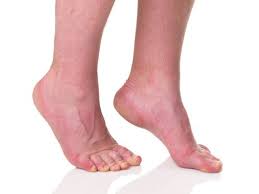Ankle Equinus

Written by Michelle Champlin BSc Pod., M.Ch.S., S.R., Ch., (UK)
What is Ankle Equinus?
Your ankle is a ‘hinge’ joint that is designed to move in only two directions: foot up (dorsiflexion) and foot down (plantar flexion). You’ll notice when you point your toes up and then down that your foot has much more range downwards than it does upwards. Normal range of motion is about 20° when pointing toes up and more when pointed down – about 50°.
Ankle equinus is the term used to describe reduced range of upwards motion, or dorsiflexion, in the ankle. It can occur in one or both ankles and to various degrees. Chief Podiatrist Michelle Champlin explains “The term ‘equinus’ was borrowed from horses – equine – whose feet are plantar flexed and essentially walking on their toes.”
What are the signs?
People will not tend to know that they have ankle equinus. Instead, they tend to visit a Podiatrist or Doctor complaining of other foot, ankle or leg problems. At Dubai Podiatry Centre, we thoroughly assess patients for any underlying biomechanical causes in order to thoroughly treat and address the root cause.
Patients with ankle equinus will commonly compensate (or alter) for the reduced upwards flexibility or motion of their ankle joint, without realizing it when they are walking or running. This ‘compensation’ in walking style often results in other foot, leg or back problems.
Heel strike with your toes pointing up off the ground is the first part of how we take a step when walking. With reduced ability to point the toe up, this means that people with ankle equinus may:
• Be prone to toe walking
• Pick the heel up early when walking
• Bend abnormally at the hip or knee when walking
• Have flattened foot arches
Causes of Ankle Equinus
• Tight Achilles tendon
• Tight calf muscle(s) – the solus and/or gastrocnemius
This tightness can be
• Inherited (congenital)
• Acquired due to injury – especially after being in a cast or on crutches
• Bone fragments from an old ankle break can block or adversely affect full range of motion
• Excessive use of high heels (Dolly Parton famously cannot walk without high heels due to overuse and tightness of the Achilles)
• Diabetes – can cause tightness of the Achilles
• Due to a significant leg length discrepancy
• As a result of an underlying neurological disorder
Ankle Equinus can result in other foot and leg issues, largely due to the ‘compensation’ when walking as other muscles, tendons and ligaments change how and when they move to help walking:
• Plantar fasciitis
• Achilles tendonitis
• Metatarsalgia
• Bunions
• Hammertoes
• Callous or sores on the forefoot (behind the toes)
• Ankle pain
• Shin splints
• Collapsed medial long arch of the foot
• Calf muscle cramps
Treatment for Ankle Equinus
When you see your Podiatrist, most likely for one or more of the above symptoms, she will identify a reduced range of motion in the ankle and diagnose ankle equinus, if that’s the underlying cause. There are many other causes of any of the issues above, so it’s important to see a qualified, reputable biomechanics Podiatrist for a thorough and specialized lower limb assessment and diagnosis as well as appropriate treatment.
Treatment to address ankle equinus will aim to address the muscle / tendon imbalance and tightness, as well as the resultant increased pressure on your forefoot. Depending on each person, this may include heel lifts to reduce strain at the back of the heel / calf, custom orthotics to redistribute pressure from the forefoot and correct foot posture and gait. A custom orthotic will be designed to control your foot motion when walking or running and you’ll normally be asked to return to the Podiatrist for review to check on your progress. The Podiatrist can also advise on stretching exercises for your calf muscles. In some cases, Chief Podiatrist Michelle Champlin says “you may be referred to a specialist foot and ankle surgeon in cases where the equinus is due to bone fragments, for example.”
If you are concerned about stiffness in your ankle joint, or pain in your legs or feet, contact the UAE’s leading foot and leg specialists, Dubai Podiatry Centre, on +971 4 3435390.

